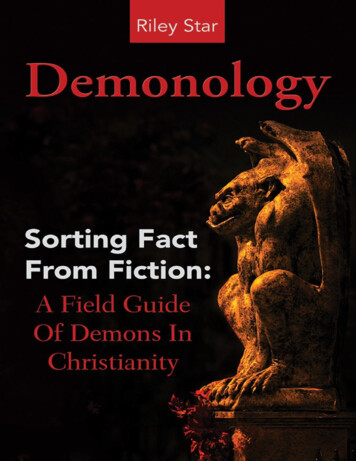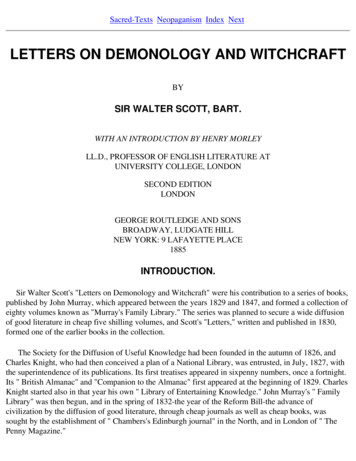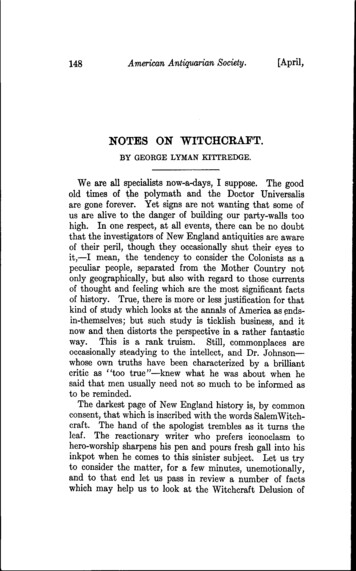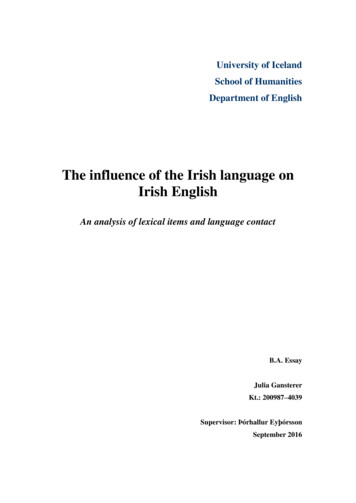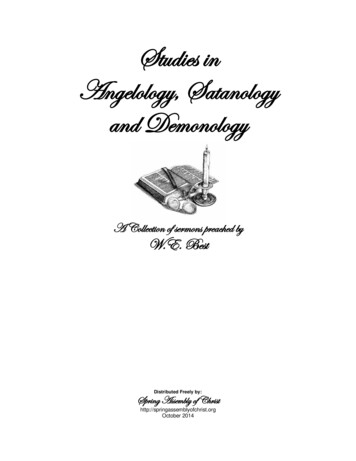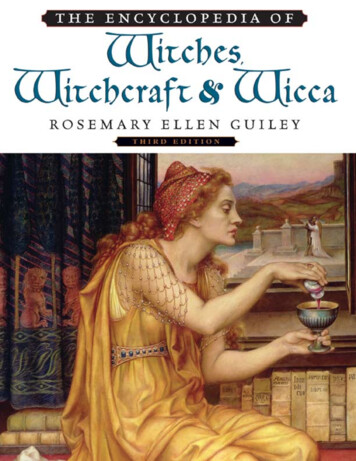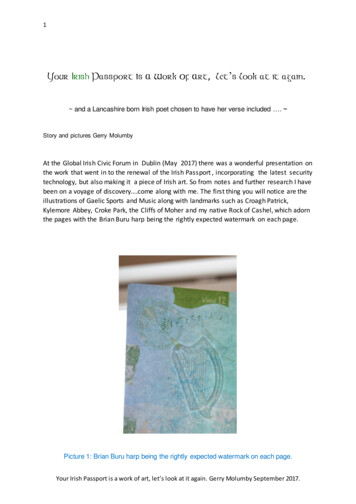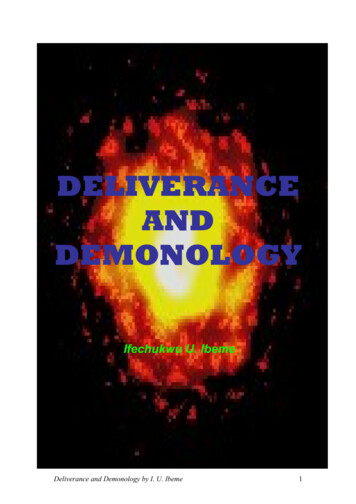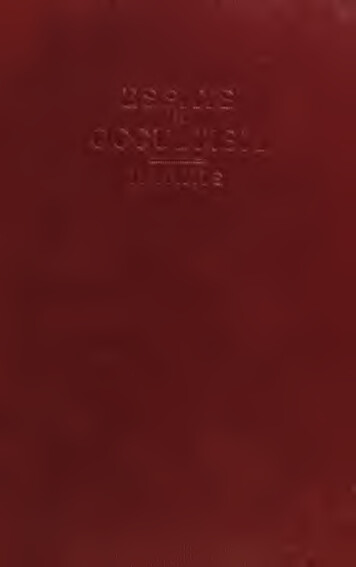
Transcription
IRISH WITCHCRAFT ANDDEMONOLOGYby St. JOHN D. SEYMOUR, B.D.[1913]This is a survey of the Witch persecution in Ireland, as well as a wide array ofother paranormal events such as poltergeists, ghosts, apparations and even anearly UFO account. Very readable, yet well documented, this book has theextensive and fascinating quotes from historical source documents.Seymour proposes that the witch-craze was more muted in Ireland than elsewhere inEurope. Relatively speaking, there appear to have been fewer cases in Ireland. Thisdoesn't mean that the consequences were any less harsh for the accused. In these texts wecan see how people exhibiting what we would today consider schizophrenic or senilebehavior were vulnerable to being accused of witchcraft.CONTENTSCHAPTER ISOME REMARKS ON WITCHCRAFT IN IRELAND1CHAPTER IIA.D. 1324DAME ALICE KYTELER, THE SORCERESS OF KILKENNY25
CHAPTER IIIA.D. 1223-1583THE KYTELER CASE AND ITS SURROUNDINGS OF SORCERY AND HERESY--MICHAELSCOT--THE FOURTH EARL OF DESMOND--JAMES I AND THE IRISH PROPHETESS--ASORCERY ACCUSATION OF 1447--WITCHCRAFT TRIALS IN THE SIXTEENTH CENTURY-STATUTES DEALING WITH THE SUBJECT--EYE-BITERS--THE ENCHANTED EARL OF46DESMONDp. viCHAPTER IVA.D. 1606-1656A CLERICAL WIZARD--WITCHCRAFT CURED BY A RELIC--RAISING THE DEVIL INIRELAND--HOW HE WAS CHEATED BY A DOCTOR OF DIVINITY--STEWART AND THEFAIRIES--REV. ROBERT BLAIR AND THE MAN POSSESSED WITH A DEVIL--STRANGEOCCURRENCES NEAR LIMERICK--APPARITIONS OF MURDERED PEOPLE ATPORTADOWN--CHARMED LIVES--VISIONS AND PORTENTS--PETITION OF ABEWITCHED ANTRIM MAN IN ENGLAND--ARCHBISHOP USSHER'S PROPHECIES--MR.BROWNE AND THE LOCKED CHEST77CHAPTER VA.D. 1661FLORENCE NEWTON, THE WITCH OF YOUGHAL105CHAPTER VIA.D. 1662-1686132
THE DEVIL AT DAMERVILLE--AND AT BALLINAGARDE--TAVERNER AND HADDOCK'SGHOST--HUNTER AND THE GHOSTLY OLD WOMAN--A WITCH RESCUED BY THEDEVIL--DR. WILLIAMS AND THE HAUNTED HOUSE IN DUBLIN--APPARITIONS SEEN INTHE AIR IN CO. TIPPERARY--A CLERGY-MAN p. vii AND HIS WIFE BEWITCHED TODEATH-BEWITCHING OF MR. MOOR--THE FAIRY-POSSESSED BUTLER--A GHOSTINSTIGATES A PROSECUTION--SUPPOSED WITCHCRAFT IN CO. CORK--THE DEVILAMONG THE QUAKERSCHAPTER VIIA.D. 1688AN IRISH-AMERICAN WITCH176CHAPTER VIIIA.D. 1689-1720PORTENT ON ENTRY OF JAMES II--WITCHCRAFT IN CO. ANTRIM--TRADITIONALVERSION OF SAME--EVENTS PRECEDING THE ISLAND--MAGEE WITCH-TRIAL--THETRIAL ITSELF--DR. FRANCIS HUTCHINSON194CHAPTER IXA.D. 1807TO PRESENT DAY MARY BUTTERS, THE CARNMONEY WITCH--BALLAD ON HER--THEHAND OF GLORY--A JOURNEY THROUGH THE AIR--A "WITCH" IN 1911--SOME MODERNILLUSTRATIONS OF CATTLE- AND MILK- MAGIC--TRANSFERENCE OF DISEASE BY Acailleach--BURYING THE SHEAF--J.P.'S COMMISSION--CONCLUSION224
IRISH WITCHCRAFT ANDDEMONOLOGYCHAPTER ISOME REMARKS ON WITCHCRAFT IN IRELANDIT is said, though we cannot vouch for the accuracy of the statement, that in acertain book on the natural history of Ireland there occurs a remarkable and oftquoted chapter on Snakes--the said chapter consisting of the words, "There areno snakes in Ireland." In the opinion of most people at the present day a book onWitchcraft in Ireland would be of equal length and similarly worded, except for theinclusion of the Kyteler case in the town of Kilkenny in the first half of thefourteenth century. For, with the exception of that classic incident, modern writersseem to hold that the witch-cultp. 2never found a home in Ireland as it did elsewhere. For example, the article on"Witchcraft" in the latest edition of the Encyclopædia Britannica mentionsEngland and Scotland, then passes on to the Continent, and altogether ignoresthis country; and this is, in general, the attitude adopted by writers on the subject.In view of this it seems very strange that no one has attempted to show why theGreen Isle was so especially favoured above the rest of the civilised world, orhow it was that it alone escaped the contracting of a disease that not for yearsbut for centuries had infected Europe to the core. As it happens they may sparethemselves the labour of seeking for an explanation of Ireland's exemption, forwe hope to show that the belief in witchcraft reached the country, and took afairly firm hold there, though by no means to the extent that it did in Scotland andEngland. The subject has never been treated of fully before, though isolatednotices may be found here and there; this book, however imperfect it may be,
can fairly claim to be the first attempt to collect the scattered stories and recordsof witchcraft in Irelandp. 3from many out-of-the-way sources, and to present them when collected in aconcise and palatable form. Although the volume may furnish little or nothing newto the history or psychology of witchcraft in general, yet it may also claim to be anunwritten chapter in Irish history, and to show that in this respect a considerableportion of our country fell into line with the rest of Europe.At the outset the plan and scope of this book must be made clear. It will benoticed that the belief in fairies and suchlike beings is hardly touched upon at all,except in those instances where fairy lore and witchcraft become inextricablyblended.The reason for this method of treatment is not hard to find. From the AngloNorman invasion down the country has been divided into two opposing elements,the Celtic and the English. It is true that on many occasions these coalesced inpeace and war, in religion and politics, but as a rule they were distinct, and thisbecame even more marked after the spread of the Reformation. It was thereforein the Anglo-Norman (and subsequently in thep. 4Protestant) portion of the country that we find the development of witchcraft alongsimilar lines to those in England or the Continent, and it is with this that we aredealing in this book; the Celtic element had its own superstitious beliefs, butthese never developed in this direction. In England and Scotland during themediæval and later periods of its existence witchcraft was an offence against thelaws of God and man; in Celtic Ireland dealings with the unseen were notregarded with such abhorrence, and indeed had the sanction of custom andantiquity. In England after the Reformation we seldom find members of theRoman Catholic Church taking any prominent part in witch cases, and this isequally true of Ireland from the same date. Witchcraft seems to have beenconfined m the Protestant party, as far as we can judge from the material at ourdisposal, while it is probable that the existence of the penal laws (active or
quiescent) would deter the Roman Catholics from coming into any prominence ina matter which would be likely to attract public attention to itself in such a markeddegree. A certainp. 5amount of capital has been made by some partisan writers out of this, but toimagine that the ordinary Roman Catholic of, let us say, the seventeenth century,was one whit less credulous or superstitious than Protestant peers, bishops, orjudges, would indeed be to form a conception directly at variance with experienceand common sense. Both parties had their beliefs, but they followed differentchannels, and affected public life in different ways.Another point with reverence to the plan of this work as indicated by the titleneeds a few words of explanation. It will be seen by the reader that the volumedoes not deal solely with the question of witchcraft, though that we haveendeavoured to bring into prominence as much as possible, but that tales of thesupernatural, of the appearance of ghosts, and of the Devil, are also included,especially in chapters IV and VI. If we have erred in inserting these, we have atleast erred in the respectable company of Sir Walter Scott, C. K. Sharpe, andother writers of note. We have included them, partly because they affordinteresting reading, and are culled from sources with whichp. 6the average reader is unacquainted, but principally because they reflect as in amirror the temper of the age, and show the degree to which every class ofSociety was permeated with the belief in the grosser forms of the supernatural,and the blind readiness with which it accepted what would at the present day betossed aside as unworthy of even a cursory examination. This is forcibly broughtout in the instance of a lawsuit being undertaken at the instigation of a ghost--aquaint item of legal lore. The judge who adjudicated, or the jury and lawyers whotook their respective parts in such a case, would with equal readiness have triedand found guilty a person on the charge of witchcraft; and probably did so faroftener than we are aware of.
The question will naturally be asked by the reader--what reason can be offeredfor Ireland's comparative freedom from the scourge, when the whole of Europewas so sorely lashed for centuries? It is difficult fully to account for it, but theconsideration of the following points affords a partial explanation.In the first place Ireland's aloofness mayp. 7be alleged as a reason. The "Emerald Gem of the Western World" lies far awayon the verge of Ocean, remote from those influences which so profoundlyaffected popular thought in other countries. It is a truism to say that it has beenseparated from England and the Continent by more than geographical features,or that in many respects, in its ecclesiastical organisation, its literature, and soon, it has developed along semi-independent lines. And so, on account of thisremoteness. it would seem to have been prevented from acquiring andassimilating the varying and complex features which went to make up thewitchcraft conception. Or, to put it in other words, mediæval witchcraft was abyproduct of the civilisation of the Roman Empire. Ireland's civilisation developedalong other and more barbaric lines, and so had no opportunity of assimilatingthe particular phases of that belief which obtained elsewhere in Europe.Consequently, when the Anglo-Normans came over, they found that the nativeCelts had no predisposition towards accepting the view of the witch as anemissary of Satan andp. 8an enemy of the Church, though they fully believed in supernatural influences ofboth good and evil, and credited their Bards and Druids with the possession ofpowers beyond the ordinary. Had this country never suffered a cross-channelinvasion, had she been left to work out her destiny unaided and uninfluenced byher neighbours, it is quite conceivable that at some period in her history shewould have imbibed the witchcraft spirit, and, with the genius characteristic ofher, would have blended it with her own older beliefs, and so would haveultimately evolved a form of that creed which would have differed in many pointsfrom what was held elsewhere. As it happens, the English and their successors
had the monopoly, and retained it in their own hands; thus the Anglo-Normaninvaders may be given the credit of having been the principal means ofpreventing the growth and spread of witchcraft in Celtic Ireland.Another point arises in connection with the advance of the Reformation inIreland. Unfortunately the persecution of witches did not cease in the countrieswhere that movement made headway--far from it; onp. 9the contrary it was kept up with unabated vigour. Infallibility was transferred fromthe Church to the Bible; the Roman Catholic persecuted the witch becauseSupreme Pontiffs had stigmatised her as a heretic and an associate of Satan,while the Protestant acted similarly because Holy Writ contained the grimcommand "Thou shalt not suffer a witch to live." Thus persecution flourishedequally in Protestant and Roman Catholic kingdoms. But in Ireland the conditionswere different. We find there a Roman Catholic majority, not racially predisposedtowards such a belief, debarred by their religious and political opinions fromtaking their full share in public affairs, and opposed in every way to the Protestantminority. The consequent turmoil and clash of war gave no opportunity for thewitchcraft idea to come to maturity and cast its seeds broadcast; it was trampledinto the earth by the feet of the combatants, and, though the minority believedfirmly in witchcraft and kindred subjects, it had not sufficient strength to make thebelief general throughout the country.p. 10A third reason that may be brought forward to account for the comparativeimmunity of Ireland was the total absence of literature on the subject. Thediffusion of books and pamphlets throughout a country or district is one of therecognised ways of propagating any particular creed; the friends and opponentsof Christianity have equally recognised the truth of this, and have always utilisedit to the fullest extent. Now in England from the sixteenth century we find anenormous literary output relative to witchcraft, the majority of the works being insupport of that belief. Many of these were small pamphlets, which served as the"yellow press" of the day; they were well calculated to arouse the superstitious
feelings of their readers, as they were written from a sensational standpoint-indeed it seems very probable that the compilers, in their desire to produce astartling catch-penny which would be sure to have a wide circulation,occasionally drew upon their imaginations for their facts. The evil that waswrought by such amongst an ignorant and superstitious people can well beimagined; unbelievers would bep. 11converted, while the credulous would be rendered more secure in their credulity.At a later date, when men had become practical enough to question the reality ofsuch things, a literary war took place, and in this "battle of the books" we findsuch well-known names as Richard Baxter, John Locke, Meric Casaubon,Joseph Glanvil, and Francis Hutchinson, ranged on one side or the other. Thusthe ordinary Englishman would have no reasonable grounds for being ignorant ofthe power of witches, or of the various opinions held relative to them. In Ireland,on the other hand (with the solitary exception of a pamphlet of 1699, which mayor may not have been locally printed), there is not the slightest trace of anywitchcraft literature being published in the country until we reach the openingyears of the nineteenth century. All our information therefore with respect toIreland comes from incidental notices in books and from sources across thewater. We might with reason expect that the important trial of Florence Newton atYoughal in 1661, concerning the historical reality of which there can be nopossible doubt, would bep. 12immortalised by Irish writers and publishers, but as a matter of fact it is onlypreserved for us in two London printed books. There is no confusion betweencause and effect; books on witchcraft would, naturally, be the result of witchtrials, but in their turn they would be the means of spreading the idea and ofintroducing it to the notice of people who otherwise might never have shown theleast interest in the matter. Thus the absence of this form of literature in Irelandseriously hindered the advance of the belief in (and consequent practice of)witchcraft.
When did witchcraft make its appearance in Ireland, and what was its progresstherein? It seems probable that this belief, together with certain aspects of fairylore hitherto unknown to the Irish, and ideas relative to milk and butter magic,may in the main be counted as results of the Anglo-Norman invasion, though it ispossible that an earlier instalment of these came in with the Scandinavians. Withour present knowledge we cannot trace its active existence in Ireland furtherback than the Kyteler case of 1324; and this, though it was almostp. 13certainly the first occasion on which the evil made itself apparent to the generalpublic, yet seems to have been only the culmination of events that had beenquietly and unobtrusively happening for some little time previously. The languageused by the Parliament with reference to the case of 1447 would lead us to inferthat nothing remarkable or worthy of note in the way of witchcraft or sorcery hadoccurred in the country during the intervening century and a quarter. For anotherhundred years nothing is recorded, while the second half of the sixteenth centuryfurnishes us with two cases and a suggestion of several others.It is stated by some writers (on the authority, we believe, of an early editor ofHudibras) that during the rule of the Commonwealth Parliament thirty thousandwitches were put to death in England. Others, possessing a little common sense,place the number at three thousand, but even this is far too high. Yet it seems tobe beyond all doubt that more witches were sent to the gallows at that particularperiod than at any other in English history. Ireland seems to have escaped scotfree--atp. 14least we have not been able to find any instances recorded of witch trials at thattime. Probably the terribly disturbed state of the country, the tremendousupheaval of the Cromwellian confiscations, and the various difficulties anddangers experienced by the new settlers would largely account for this immunity.Dr. Notestein 1 shows that the tales of apparitions and devils, of knockings andstrange noises, with which English popular literature of the period is filled, areindications of a very overwrought public mind; of similar stories in Ireland, also
indicative of a similar state of tension, some examples are given in chapter IV.Though the first half of the seventeenth century is so barren with respect towitchcraft, yet it should be noticed that during that period we come acrossfrequent notices of ghosts, apparitions, devils, &c., which forces us to theconclusion that the increase of the belief in such subjects at that time was almostentirely due to the advent of the Cromwellian settlers and the Scotch colonists inUlster; indeed the beliefs of the latterp. 15made the Northern Province a miniature Scotland in this respect. We cannotblame them for this; could anything else be expected from men who, clergy andlaity alike, were saturated with the superstitions that were then so prominent inthe two countries from which their ranks had been recruited?Thus the seventeenth century was the period par excellence of witchcraft,demonology, and the supernatural in Ireland. The most remarkable witch case ofthat time, the trial of Florence Newton in 1661, to which allusion has alreadybeen made, seems to have been largely influenced by what occurred in England,while the various methods suggested or employed as a test of that old woman'sculpability are quite in accordance with the procedure adopted a few yearspreviously by the English witch-finder general, the infamous Matthew Hopkins.After 1711 the period of decadence is reached, while between that date and1808 nothing has been found, though it may be safely inferred that that blankwas filled by incidents similar to the case of Mar Butters and others, as describedin the final chapter; and possibly too, as inp. 16England, by savage outbursts on the part of the ignorant and credulousmultitude.Witchcraft never flourished to any great extent in Ireland, nor did anything everoccur which was worthy of the name of persecution-except perhaps as a sequelto the Kyteler case, and the details of which we fear will never be recovered. Thefirst part of this statement must be taken generally and not pressed too closely,as it is based almost entirely on negative evidence, i.e. the absence of
information on the subject. England has a lengthy list of books and pamphlets,while Scotland's share in the business may be learnt from the fine series ofcriminal trials edited by Pitcairn in. the Miscellanies of the Abbotsford Club, not tospeak of other works; notwithstanding these, many cases in both England andScotland must have been unrecorded. Ireland can produce nothing like this, for,as we have already shown, all printed notices of Irish witchcraft, with onepossible exception, are recorded in books published outside the country.Nevertheless, if all likely sources, both in MS. and print, could be searched, it ishighly probable that ap. 17much fuller volume than the present one could be written on the subject. TheElizabethan Act was passed on account of cases (recorded and unrecorded) thathad arisen in the country; while, human nature being what it is, it seems likelythat the very passing of that Statute by the Irish Parliament was in itself asufficient incentive to the witches to practise their art. No belief really gainsground until it is forbidden; then the martyrs play their part, and there is aconsequent increase in the number of the followers.The Act of 1634 shows the opinion that was entertained in the highest circlesrelative to the baneful influence of witches and the menace their presence was tothe safety of the community at large; in this no doubt the effect of the "evil eye,"or of the satirical verses of Bards, would be equally classed with witchcraftproper.From various hints and incidental notices, such as in the account of thebewitching of Sir George Pollock, or in Law's statement relative to the case of Mr.Moor, as well as from a consideration of the prevalence of the belief amongst allclasses of society, it mayp. 18be inferred that far more cases of witchcraft occurred in Ireland during thesixteenth and seventeenth centuries than one imagines, though in comparisonwith other countries their numbers would be but small. Future students of old
documents may be able to bear out this statement, and to supply information atpresent unavailable.To deal with the subject of witchcraft in general, with its psychology or with themany strange items which it included, would be out of place in a work exclusivelydevoted to one particular country, nor indeed could it be adequately dealt with inthe space at our disposal; it is necessary, however, to say a few words on thematter in order to show by comparison how much pain and unhappiness thepeople of Ireland escaped through the non-prevalence of this terrible cultamongst them.In the first place, to judge from the few witch-trials recorded, it may be claimedthat torture as a means of extracting evidence was never used upon witches inIreland (excepting the treatment of Petronilla of Meath by Bishop de Ledrede,which seems to have been carried out isp. 19in what may be termed a purely unofficial manner). It would be interesting indeedto work through the extant Records for the purpose of seeing how often torturewas judicially used on criminals in Ireland, and probably the student whoundertakes the investigation will find that this terrible and illogical method ofextracting the truth (!) was very seldom utilised. Nor is it at all clear that torturewas employed in England in similar trials. Dr. Notestein 1 thinks that there aresome traces of it, which cannot however be certainly proved, except in oneparticular instance towards the end of the reign of James I, though this was forthe exceptional crime of practising sorcery (and therefore high treason) againstthat too credulous king. Was its use ever legalised by Act of Parliament in eithercountry?In Scotland, on the other hand, it was employed with terrible frequency; therewas hardly a trial for witchcraft or sorcery but some of the unfortunatesincriminated were subjected to this terrible ordeal. Even as late as 1690 torturewas judicially applied top. 20
extract evidence, for in that year a Jacobite gentleman was questioned by theboots. But Scotland, even at its worst, fades into insignificance before certainparts of the Continent, where torture was used to an extent and degree that canonly be termed hellish; the appalling ingenuity displayed in the various methodsof applying the "question extraordinary" seems the work of demons rather than ofChristians, and makes one blush for humanity. The repetition of torture wasforbidden, indeed, but the infamous Inquisitor, James Sprenger, imagined asubtle distinction by which each fresh application was a continuation and not arepetition of the first; one sorceress in Germany suffered this continuation noless, than fifty-six times.Nor was the punishment of death by fire for witchcraft or sorcery employed to anyextent in Ireland. We have one undoubted instance, and a general hint of' someothers as a sequel to this. How the two witches were put to death in 1578 we arenot told, but probably it was by hanging. Subsequent to the passing of the Act of1586 the method of execution wouldp. 21have been that for felony. On the Continent the stake was in continual request. In1514 three hundred persons were burnt alive for this crime at Como. Between1615 and 1635 more than six thousand sorcerers were burnt in the diocese ofStrasburg, while, if we can credit the figures of Bartholomew de Spina, inLombardy a thousand sorcerers a year were put to death for the space of twenty-five years. 1 The total number of persons executed in various ways for this crimehas, according to the Encyclopædia Britannica, been variously estimated at fromone hundred thousand to several millions; if the latter figure be too highundoubtedly the former is far too low.In the persecution of those who practised magical arts no rank or class in societywas spared; the noble equally with the peasant was liable to torture and death.This was especially true of the earlier stages of the movement when sorceryrather than witchcraft was the crime committed. For there is a general distinctionbetween the two,p. 22
though in many instances they are confounded. Sorcery was, so to speak, moreof an aristocratic pursuit; the sorcerer was the master of the Devil (until hisallotted time expired), and compelled him to do his bidding: the witch generallybelonged to the lower classes, embodied in her art many practices which lay onthe borderland between good and evil, and was rather the slave of Satan, whoalmost invariably proved to be a most faithless and unreliable employer. For anillustration from this country of the broad distinction between the two the readermay compare Dame Alice Kyteler with Florence Newton. Anybody might becomea victim of the witch epidemic; noblemen, scholars, monks, nuns, titled ladies,bishops, clergy--none were immune from accusation and condemnation. Nay,even a saint once fell under suspicion; in 1595 S. Francis de Sales was accusedof having been present at a sorcerers' sabbath, and narrowly escaped beingburnt by the populace. 1 Much more might be written in the same strain, butp. 23sufficient illustrations have been brought forward to show the reader that in itscomparative immunity from witchcraft and its terrible consequences Ireland,generally deemed so unhappy, may be counted the most fortunate country inEurope.In conclusion, we have not considered it necessary to append a bibliography.The books that have been consulted and which have contained no informationrelative to Ireland are, unfortunately, all too numerous, while those that haveproved of use are fully referred to in the text or footnotes of the present volume.We should like however to acknowledge our indebtedness to such general workson the subject as Sir Walter Scott's Demonology and Witchcraft, C. K. Sharpe'sHistory of Witchcraft in Scotland, John Ashton's The Devil in Britain and America,and Professor Wallace Notestein's History of Witchcraft in England, 1558-1718(Washington, 1911); the last three contain most useful bibliographical notices.Much valuable information with respect to the traditional versions of certainincidents which occurred in Ulster has been gleaned from Classon Porter'spamphlet,p. 24
Witches, Warlocks, and Ghosts (reprinted from The Northern Whig of 1885). Fora good bird's-eye view of witchcraft on the Continent from the earliest times wecan recommend J. Français' L'église et la Sorcellerie (Paris: Nourry, 1910).Footnotes14:1 In his History of Witchcraft in England.19:1 Notestein, 10. op. cit.21:1 Français, L'église et la Sorcellerie.22:1 Français, op. cit.CHAPTER IIA.D. 1324DAME ALICE KYTELER, THE SORCERESS OFKILKENNYTHE history of the proceedings against Dame Alice Kyteler and her confederateson account of their dealings in unhallowed arts is to be found in a MS. in theBritish Museum, and has been edited amongst the publications of the CamdenSociety by Thomas Wright, who considers it to be a contemporary narrative.Good modern accounts of it are given in the same learned antiquary's"Narratives of Witchcraft and Sorcery" in Transactions of the OssoryArchæological Society, vol. i., and in the Rev. Dr. Carrigan's History of theDiocese of Ossory, vol. i.
Dame Alice Kyteler (such apparently being her maiden name), the facile princepsof Irish witches, was a member of a good Anglo-Norman family that had beensettledp. 26in the city of Kilkenny for many ears. The coffin-shaped tombstone of one of herancestors, Jose de Keteller, who died in 128-, is preserved at S. Mary's church;the inscription is in Norman-French and the lettering is Lombardic. The lady inquestion must have been far removed from the popular conception of a witch asan old woman of striking ugliness, or else her powers of attraction were veryremarkable, for she had succeeded in leading four husbands to the altar. Shehad been married, first, to William Outlawe of Kilkenny, banker; secondly, toAdam le Blund of Callan; thirdly, to Richard de Valle--all of whom she wassupposed to have got rid of by poison; and fourthly, to Sir John le Poer, whom itwas said she deprived of his natural senses by philtres and incantations.The Bishop of Ossory at this period was Richard de Ledrede, a Franciscan friar,and an Englishman by birth. He soon learnt that things were not as they shouldbe, for when making a visitation of his diocese early in 1324 he found by anInquisition, in which were five knights and numerousp. 27nobles, that there was in the city a band of heretical sorcerers, at the head ofwhom was Dame Alice. The following charges were laid against them.1. They had denied the faith of Christ absolutely for a year or a month, accordingas the object they desired to gain through sorcery was of greater
IRISH WITCHCRAFT AND DEMONOLOGYDEMONOLOGY by St. JOHN D. SEYMOUR, B.D. by St. JOHN D. SEYMOUR, B.D. [1913][1913] This is a survey of the
